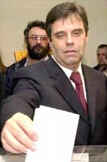
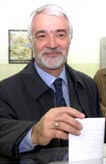 On
a 29 September:
On
a 29 September: 2002 Presidential election in Serbia, which barely avoids getting annuled as it would have been if less than 50% of the electorate voted (55% did; the same rule applies to the run-off). Vojislav Kostunica, 58 [< photo] (president of Yugoslavia, due to be dissolved at end of 2002 while keeping loose Serbia-Montenegro ties), gets 31% of the votes to 28% for Miroljub Labus, 55 [photo >]. Since no one got 50% or more, there will be a runoff election between the two on 13 October 2002, in which Kostunica comes gets 67% of the vote and Labus 31%, but which is annulled because only 45% of the electorate votes. Vojislav Seselj (Serbian Radical Party), endorsed by genocidal Milosevic on trial at the Hague, gets 23% of the vote. The other candidates are Velimir Bata Zivojinovic (3.2%), a former actor; Vuk Draskovic (4.5%), a former key opposition leader who fell from grace after joining Milosevic's government during NATO's 1999 air war to end Milosevic's genocide of ethnic Albanians in Kosovo; Nebojsa Pavkovic (2%), Milosevic's former army commander; Branislav Ivkovic (1.1%), a Socialist Party dissident; Vuk Obradovic (4.5%) a former general; Borislav Pelevic (3.9%), an ultranationalist; businessman Dragan Radenovic (0.2%); and businessman Tomislav Lalosevic (0.7%). Serbia's current president, Milan Milutinovic, didn't seek re-election because he is wanted by the UN court on war crimes charges related to the war in Kosovo.
2002 Second and last day of local council elections in Zimbabwe. White legislator Roy Bennett of the opposition Movement for Democratic Change is arrested together with 8 others who are badly beaten; they include his bodyguard. President Robert Mugabe and his ZANU-PF party are using violence to win the election, just as he did in the Mach 2002 presidential election, and has been doing to disposses the White farmers who owned 70% of the land.
1999 Russian news media report start of Chechnya ground operation (CNN)
1997 Microsoft releases Windows CE version 2, designed to support processors embedded in hand-held devices and home appliances. The operating system supports 32-bit color screens and a variety of screen sizes. The new version of CE set the stage for a number of new mobile computing devices.
1996 The organization that supervised Bosnia's first post-war elections certifies the results - with victories by nationalist parties and the country's Muslim president, Alija Izetbegovic.
1991 California Gov. Pete Wilson vetoed a bill outlawing job discrimination against homosexuals, saying it could have led to unjustified lawsuits.
1988 UN peacekeeping forces win Nobel Peace prize
| 1987 Televangelist resigns to
pursue US presidency. Pat Robertson resigns from his ministries to pursue the Republican presidential nomination full time. He also resigns his credentials as an ordained minister. For a few weeks in 1987, it looked as if a conservative Christian could give secular politicians a real battle for the American presidency. Televangelist Pat Robertson, the host of the 700 Club and creator of the Christian Broadcasting Network (CBN), won three early caucuses including victories in Michigan and South Carolina and had gathered more campaign funds than most rivals. Like many evangelicals, Robertson wanted to see Christian values brought into the American political arena. Many recent decisions had left conservatives feeling America was no longer their country. Prayer had been banned from schools; the ten commandments removed from educational establishments; abortion legalized; pornography permitted; and many other social, economic and international trends contrary to the faith were granted governmental support at taxpayers' expense. Those taxpayers included many persons of Robertson's persuasion. CBN's 700 Club had 12 million viewers. Those who tuned in saw a man who spoke articulately of national and international issues, finances and Christian values. His newscasts presented an alternative to the mainstream media. Inspirational stories were re-enacted before cameras for watching millions. Belief in God's power to answer prayer with miracles was strong. Robertson also "prophesied," but the predictions were unimpressive. Faith healing was part of his show. He would pray rather generically for "someone out there" with a neck, back, heart or other problem and claim that the person would be healed. Listeners wrote in saying they were healed at the moment he prayed. His was a devoted audience. The question was, could Pat Robertson put together a larger coalition? His three early wins suggested he might. Robertson had politics in his blood and background. His father had been a senator and he himself had worked in various political capacities. Yet he had a "God-shaped vacuum" in his life. His prayerful mother and a Baptist missionary led him to Christ. "I believed Jesus Christ died for the sins of the world and my sins, too, and it was like a light went on!" He had been contemplating suicide but now found new direction and joy. Robertson did not win the Republican nomination or the presidency. George Bush did. Robertson stumbled badly when allegations surfaced that he had used his senator father's influence as a young man to evade dangerous military service. He was soon back at CBN. Nonetheless, his bid for presidency was valuable. It gave conservative Christians a chance to air their values in the public arena. Many who otherwise felt disenfranchised in the United States obtained a sense that someone out there spoke for them after all. After Robertson returned to CBN he built it into The Family Channel and secularized it. He later sold The Family Channel and it's parent, International Family Entertainment, for over one and a half billion dollars, to media magnate Rupert Murdock. |
| 1986 Bipartisan tax reform followed
by partisan self-congratulation
^top^ The Democrats and Republicans introduce sweeping tax reform legislation. After the Senate approved the bill, both parties tried to take exclusive credit for the legislation. The bill, which promised to reduce rates by slashing preferences for people in top tax brackets, held the type of populist appeal that seemed ready-made to win voters. Republicans viewed it as a promising opportunity to make their party more appealing to the working class, and Democrats, protective of their traditional blue-collar allies, reminded whoever would listen that key GOP officials had, in fact, tried to derail the legislation. Credit ultimately belonged to President Reagan, who was hailed for guiding the bill safely through Congress. While Reagan was enjoying the praise, Democrats tried in vain to tie the policy back to Senators Bill Bradley and Richard Gephardt, who co-authored the original tax overhaul bill in 1982. |
1979 Gold hits record $400.20 an ounce in Hong Kong
1979 Pope John Paul II becomes 1st pope to visit Ireland
1978 Pope John Paul I is found dead in his Vatican apartment just over a month after becoming head of the Roman Catholic Church
| 1970 Sadat becomes president
of Egypt ^top^ Egyptian Vice President Anwar el-Sadat was sworn-in as the president of Egypt following the death of Gamal Abdel Nasser the day before. In November of 1977, in an unprecedented move for an Arab leader, Egyptian President Anwar el-Sadat traveled to Jerusalem in Israel to seek a permanent peace settlement with Egypt's Jewish neighbor after decades of conflict. Sadat's visit, in which he met with Israeli Prime Minister Menachem Begin and spoke before Israel's parliament, was met with outrage in most of the Arab world. Despite criticism from Egypt's regional allies, Sadat continued to pursue peace with Begin, and in 1978 the two leaders met again in the United States, where they negotiated an agreement with US President Jimmy Carter at Camp David, Maryland. The historic treaty, the first peace agreement between the state of Israel and one of its Arab neighbors, ended three decades of war and laid the groundwork for diplomatic and commercial relations. For their achievement, Sadat and Begin were awarded a joint Nobel Peace Prize. However, Sadat's peace efforts were not so highly acclaimed in the Arab world, and he was assassinated in 1981 by Muslim extremists in Cairo. |
| 1969 Vietnam:
CIA assures immunity for US war criminals
^top^ Secretary of the Army Stanley Resor announces that the US Army, conceding that it is helpless to enlist the cooperation of the Central Intelligence Agency (CIA), is dropping the murder charges (of August 6) against eight Special Forces accused of killing a Vietnamese national. Col. Robert B. Rheault, Commander of the 5th Special Forces Group in Vietnam, and seven other Green Berets had been charged with premeditated murder and conspiracy to commit murder in the summary execution of Thai Khac Chuyen, who had served as an agent for Detachment B-57. Chuyen was reportedly summarily executed for being a double agent who had compromised a secret mission. The case against the Green Berets was ultimately dismissed for reasons of national security when the CIA refused to release highly classified information about the operations in which Detachment B-57 had been involved. Colonel Rheault subsequently retired from the Army. |
| 1965 Vietnam:
Hanoi: war not declared, so US pilots are war criminals
^top^ Hanoi publishes the text of a letter it has written to the Red Cross claiming that since there is no formal state of war, US pilots shot down over the North will not receive the rights of prisoners of war (POWs) and will be treated as war criminals. The US State Department protested, but this had no impact on the way the American POWs were treated and most suffered extreme torture and other maltreatment while in captivity. The first pilot captured by the North Vietnamese was Navy Lieutenant Everett Alvarez, who was shot down on August 5, 1964. The American POW held longest was Army Special Forces Captain Floyd James Thompson, who had been captured in the South on March 26, 1964. American POWs were held in 11 different prisons in North Vietnam and their treatment by the North Vietnamese was characterized by isolation, torture, and psychological abuse. The exact number of POWs held by the North Vietnamese during the war remains a debatable issue, but the POWs themselves have accounted for at least 766 verified captives at one point. Under the provisions of the Paris Peace Accords, the North Vietnamese released 565 American military and 26 civilian POWs in February and March 1973, but there were still more than 2500 men listed as Missing in Action (MIA). |
1959 Sultan of Brunei promulgates a constitution
| 1953 NY Times: Russians
want the American dream
^top^ An article in The New York Times claims that Russian citizens want the "American dream": private property and a home of their own. The article was one of many that appeared during the 1950s and 1960s, as the American media attempted to portray the average Russian as someone not much different from the average American. Despite the fact that the vast majority of Americans supported the anti-Soviet Union policies of their government, most had a more difficult time trying to dislike the average Russian. During World War II, after all, the US government had launched a propaganda campaign to convince the American people that the Russians — though they lived in a communist nation — were good allies in the war against Hitler's Germany. Even Hollywood got into the act, releasing movies portraying the stoically heroic Russians and their battle against the Nazi hordes. When World War II ended and the rupture between the United States and the Soviet Union began to develop into the Cold War, many Americans were confused about the new portrayal of Russia as a threat to the United States. The US government and the cooperative news media soon developed an answer to this confusion. The message they spread was clear and direct: the Soviet government was a communist dictatorship bent on world domination; the Russian people, on the other hand, were not much different from their US counterparts. They just craved freedom, liberty, and material comfort. A story in the 29 September 1953, edition of The New York Times was a perfect example of this approach. It began by explaining that a "fortunate Russian" might eventually receive a "small plot of land on which to build a home." The piece asked, "What is the first thing he does then?" According to the article, he "erects a fine, big fence all the way around the lot." Decades of communist rule had "succeeded only in sharpening the instinct of the Russian people to hold private property." The Times reporter opined that the "Soviet Government, if it wants to have a contented population, will have to go a long way in making concessions to satisfy it." The article was also evidence of the idea that some of the best American propaganda directed toward the Russian citizenry relied on describing the immense material wealth and comfort available in the United States. In 1959, the first US exhibition to be held in the Soviet Union consisted largely of automobiles, kitchen appliances, fashions, and vast amounts of other consumer goods. Nearly 3 million Russians crowded in to get a look and snatch away the catalogs. |
1950 General Douglas MacArthur officially returns Seoul, South Korea, to President Syngman Rhee.
1946 Government official Bakaric addresses students at Zagreb University, Croatia, and tells them that the government's philosophy of religion is that of Marx and Lenin.
1944 Soviet troops invade Yugoslavia
1943 Gen. Dwight D. Eisenhower and Italian Marshal Pietro Badoglio signed an armistice aboard the British ship Nelson off Malta.
1943 Adolf Hitler's book Mein Kampf is published in the United States.
| 1939 Nazis and Soviets dismember
Poland ^top^ Germany and the Soviet Union agree to divide control of occupied Poland roughly along the Bug River—the Germans taking everything west, the Soviets taking everything east. As a follow-up to the Ribbentrop-Molotov Pact, (also known as the Hitler-Stalin Pact), that created a non-aggression treaty between the two behemoth military powers of Germany and the USS.R., Joachim von Ribbentrop, the German foreign minister, met with his Soviet counterpart, V.M. Molotov, to sign the German-Soviet Boundary and Friendship Treaty. The original non-aggression pact had promised the Soviets a slice of eastern Poland; now it was merely a matter of agreeing where to draw the lines. Joseph Stalin, Soviet premier and dictator, personally drew the line that partitioned Poland. Originally drawn at the River Vistula, just west of Warsaw, he agreed to pull it back east of the capital and Lublin, giving Germany control of most of Poland's most heavily populated and industrialized regions. In return, Stalin wanted Lvov, and its rich oil wells, as well as Lithuania, on the northern border of East Prussia. Germany now had 22 million Poles, "slaves of the Greater German Empire," at its disposal; Russia had a western buffer zone. |
| 1939 USSR — Estonia Mutual Assistance
Treaty ^top^ The Soviet Union signs a Treaty of Mutual Assistance with the Baltic nation of Estonia, giving Stalin the right to occupy Estonian naval and air bases. A similar treaty would later be signed with Latvia. Soviet tanks eventually rolled across these borders, in the name of "mutual assistance," placing the Baltic States into the hands of the USS.R. for decades to come. These "treaties" were once again merely the realization of more fine print from the Ribbentrop-Molotov Pact, giving Stalin more border states as buffer zones, and protecting Russian territory where the Bolshevik ideology had not been enthusiastically embraced from intrusion by its western neighbor, namely its non-aggression partner Germany. The highly vulnerable Baltic nations had little to say about any of these arrangements; they were merely annexed. |
1937 Pope Pius XI publishes his Ingravescentibus Malis, on the Rosary
1936 Radio used for 1st time for a presidential campaign
1932 A five-day work week is established for General Motors workers.
1930 Boquerón battle ends Paraguay border dispute
| 1923 UK mandate in Palestine
^top^ Great Britain begins to govern the territory of Palestine under a mandate granted by the League of Nations, effectively ending 400 years of Turkish rule and over 1300 years of Arab rule. Britain seized Palestine from Turkey during World War I, capturing Jerusalem in 1917. Following the British takeover, a movement for the establishment of an independent Jewish state began to mount, but the outbreak of World War II stalled the negotiations. By the war's end, massive numbers of Jews had fled to Palestine, and Britain, unable to reach a compromise between Palestine's Jewish and Arab population, turned the question over to the United Nations. In November of 1947, the U.N. voted for the partition of Palestine, and with the expiration of the British mandate and withdrawal of British forces in May of 1948, the State of Israel was declared. US recognition of Israel came within hours, but so did an Arab invasion, launched by Jordan and Egypt the day after Israel's proclamation. However, by the time a cease-fire was declared in January of 1949, Israel had increased its original territory by fifty-percent. |
1915 The first transcontinental demonstration of radio telephone is a call transmitted from New York City to Arlington, Virginia, then to San Francisco and Honolulu. The work of Harold DeForest Arnold at Western Electric on thermionic tubes, which amplified radio and telephone signals, was instrumental in the long-distance transmission. Arnold later became the first director of research at Bell Telephone Labs.
| 1888 Daimler licensee will make
their engines in the US
^top^ William Steinway concludes licensing negotiations with Gottlieb Daimler, gaining permission to manufacture Daimler engines in the US He founds the "Daimler Motor Company" and begins producing Daimler engines, as well as importing Daimler boats, trucks, and other equipment to the North American market. Still, the US was just a small portion of Daimler's market, and when he introduced a new line in 1901, he christened it Mercedes because he feared the German-sounding Daimler would not sell well in France. |
| 1862 Union general murders his
commanding general. ^top^ Union General Jefferson C. Davis mortally wounds his commanding officer, General William Nelson, in Louisville, Kentucky. Davis had been upset by a reprimand handed down by Nelson. After quarreling in a hotel lobby, Nelson slapped Davis. Davis then chased him upstairs and shot him. Davis was never court-martialed, and it is thought that the influence of Indiana Governor Oliver Morton, who was with Davis at the time of the shooting, was instrumental in preventing a trial. Davis went on to serve with distinction at the Battles of Stones River, Chickamauga, and Chattanooga. |
1833 A civil war breaks out in Spain between Carlists, who believe Don Carlos deserves the throne, and supporters of Queen Isabela.
1795 Leaders of the French Revolution unify all anti-clerical laws into a single code.
1789 US Congress votes to create a unified United States Army, with a permanent strength of one thousand enlisted men and officers. The same day, Josiah Harmar is appointed the first commander-in-chief of the US Army.
1785 Chaidic sect is excommunicated in Cracow Poland
1513 Spanish explorer Vasco Nuñez de Balboa discovers the Pacific Ocean.
1493 Christopher Columbus leaves Cadiz, Spain, on his second voyage to the new world.
1399 Richard II of England is deposed. His cousin, Henry of Lancaster, declares himself king under the name Henry IV.
1349 People of Krems Austria accuse Jews of poisoning the wells.
0855 Benedict III begins his reign as Pope
0440 Pope Leo I, the Great, is consecrated. He strengthened the authority of the church, suppressed the Manichean heresy, wrote important letters, such as one on the doctrine of the Incarnation.
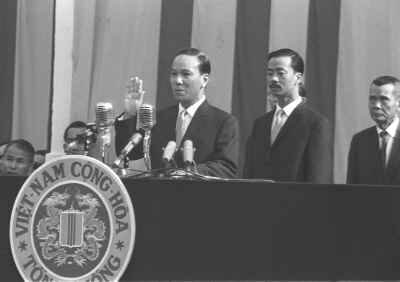 2001
2001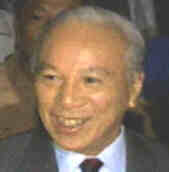 The same year that he rose to the country's highest office in
1965, holding the ceremonial post of chief-of-state, president
Lyndon Johnson ordered the first major escalation of the war,
sending more than 100'000 US soldiers to Vietnam.
The same year that he rose to the country's highest office in
1965, holding the ceremonial post of chief-of-state, president
Lyndon Johnson ordered the first major escalation of the war,
sending more than 100'000 US soldiers to Vietnam. 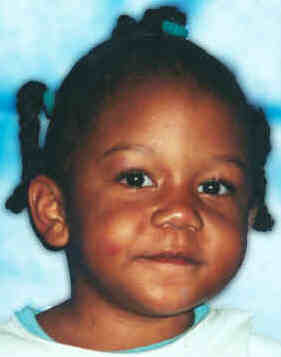 Births
Births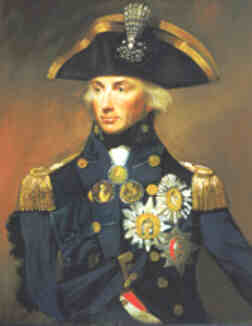 After his recovery, Nelson pursued a French expeditionary force to Egypt
and succeeded in destroying the French fleet at the Battle of the Nile
in August 1798, thereby stranding French General Napoleon Bonaparte and
his army in Egypt. Nelson was hailed as a great hero and went with his
squadron to Naples, where he began an affair with the wife of a British
minister. Nelson had a wife in England. He aided Ferdinand, king of Naples,
in his struggles against republican revolutionaries but later was recalled
to England after he refused an order to take his ships to Minorca. Due
to his overwhelming public popularity, however, Nelson was made a vice
admiral instead of being punished when he returned to England.
After his recovery, Nelson pursued a French expeditionary force to Egypt
and succeeded in destroying the French fleet at the Battle of the Nile
in August 1798, thereby stranding French General Napoleon Bonaparte and
his army in Egypt. Nelson was hailed as a great hero and went with his
squadron to Naples, where he began an affair with the wife of a British
minister. Nelson had a wife in England. He aided Ferdinand, king of Naples,
in his struggles against republican revolutionaries but later was recalled
to England after he refused an order to take his ships to Minorca. Due
to his overwhelming public popularity, however, Nelson was made a vice
admiral instead of being punished when he returned to England. 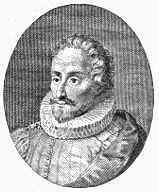 En muchas ocasiones, la realidad supera a la ficción.
Y eso mismo es lo que sucedió con la vida y la obra de
Miguel de Cervantes Saavedra. Su biografía, sin duda,
puede ser considerada como una verdadera novela de aventuras,
muy al estilo de la época que le tocó vivir. Su
vida, más prolija en experiencias negativas que en vivencias
positivas, fue curiosamente paralela a la de su más famosa
creación: el ingenioso hidalgo Don Quijote de la Mancha.
En muchas ocasiones, la realidad supera a la ficción.
Y eso mismo es lo que sucedió con la vida y la obra de
Miguel de Cervantes Saavedra. Su biografía, sin duda,
puede ser considerada como una verdadera novela de aventuras,
muy al estilo de la época que le tocó vivir. Su
vida, más prolija en experiencias negativas que en vivencias
positivas, fue curiosamente paralela a la de su más famosa
creación: el ingenioso hidalgo Don Quijote de la Mancha.